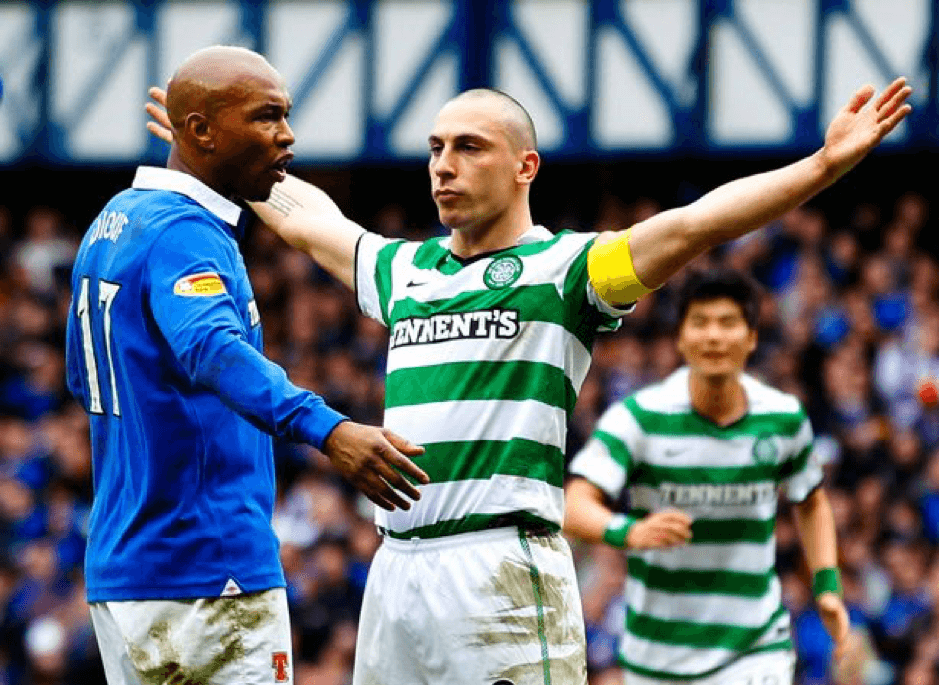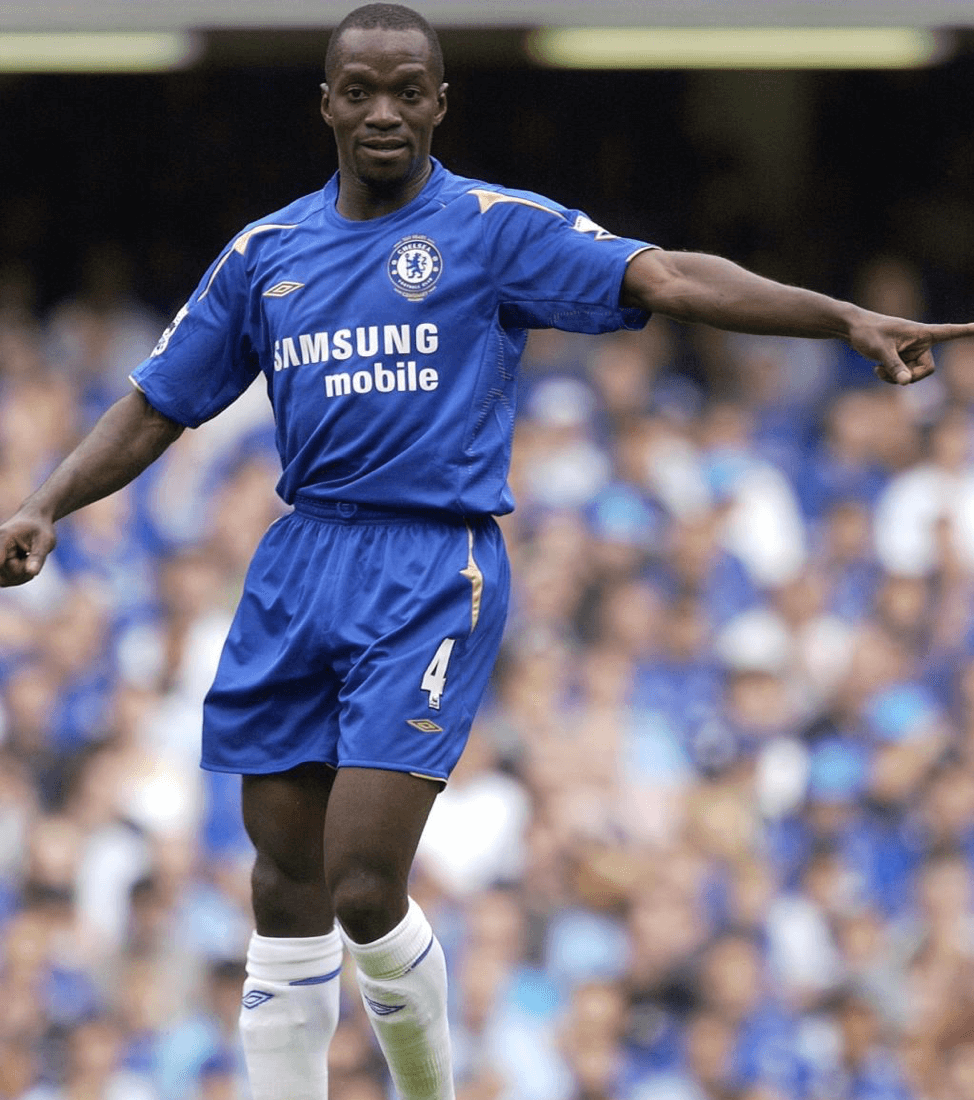The Old Firm Derby: A Fight To The Finish

Scott Brown taunted El-Hadji Diouf with the infamous ‘The Broony’ celebration after scoring a thunderous equalizer in the Old Firm Derby (Daily Record)
The pillars of animosity stem beyond local loyalties
On 28th May 1888, a newly formed Celtic invited a then-relatively obscure Rangers for a game to inaugurate their new stadium at Parkhead. Celtic beat Rangers 5-2 in what was described as a friendly encounter; that this fixture would turn into one of the most heated rivalries in world football was not even a distant possibility when the teams first met.
In fact, sources suggest that the Old Firm Derby is so called because the teams and their corresponding fans were said to be friends in the early stages of their rivalry.
To comprehend what fueled the bitter rivalry between these iconic Glasgow clubs, it is important to understand the sectarianism that has engulfed Glasgow since the 19th century.
The Old Firm Derby is far from an ordinary football match between local rivals. It is a game that represents and mirrors the religion and violence that characterizes the sectarian divide in the city of Glasgow.
It not only represents a battle between Celtic and Rangers, but also between Irish Catholics and Scottish Protestants, and between Nationalists and Unionists.
Celtic was formed for and by Irish Catholics in 1887 to raise money for impoverished immigrants who had fled Ireland to escape the famine in the 19th century. The Bhoys established themselves in the East End of Glasgow and solidified their Irish fanbase by serving as a regular meeting point for members of the Irish community who at the time, were heavily discriminated against in the city.
The club became the flagbearer of the Irish community in Glasgow as its fans aligned themselves with Irish Nationalism and home rule politics; so much so that the Celtic team logo and their green and white home kits suggest an undeniable influence of Irish culture on the ethos of the football club.
Rangers, on the other hand, was founded in 1872 in the West End of Glasgow and existed as a relatively unknown football club until the rise of its fiercest rivals.
Scotland was a predominantly Protestant country and the rise of Celtic, a football club for the Irish Catholics, meant that the Scottish football fans in the city of Glasgow needed a football club to latch onto.
However, the relationship between the two clubs only began to sour when Rangers appointed John Ure Primrose as their new club Chairman in the early stages of the 20th century.
Ure Primrose was a well-known Scottish politician who held strong anti-Catholic and Unionist beliefs, and became the driving force behind the establishment of Rangers as a Protestant team.
When matters are taken into their own hands
Local rivalries are the life force of football. Derbies can be the most intense, passionate, violent, heartbreaking, overwhelming and enthralling spectacles with clubs and their fans vying for bragging rights over an often fascinating 90 minutes of football.
The gulf in political and religious views between Celtic and Rangers fans, and their monopoly over Scottish football has propelled the Old Firm Derby to the most fervently contested game of football on the planet.
Over the years, the fixture has been laden with infamous instances of religious bigotry, offensive sectarian chanting and shocking violence.
The Scottish Cup final between Celtic and Rangers on May 10, 1980 descended into Scottish football’s worst riot for 70 years just minutes after George McCluskey’s extra-time winner secured the trophy for Celtic.
In a scene that would later be condemned as a national disgrace, both sets of supporters charged onto the field with a mere dozen mounted police officers tasked with controlling the outbreak.
Chaos ensued as an inadequate number of police officers struggled to restore order amidst flying beer bottle, missiles, fighting fans and the resultant cans, bottles and casualties.
Match commentator Archie MacPherson infamously compared the unfolding events to a scene out of war epic, ‘Apocalypse Now’. Unsurprisingly, these events led to drinking being banned from all Scottish football matches.

As mounted police had to intervene to stop the Hampden riot, the 1980 Scottish Cup final continues to not just be a dark day for the Old Firm, but for Scottish football as a whole
In 1999, Celtic faced Rangers in a game they needed to win to prevent Rangers from winning the league title.
However, what was expected to be an end-to-end battle turned into a bad-tempered game that saw a player sent off from each side as Rangers secured the title with a 3-0 win. Referee Hugh Dallas needed stitches after being struck on the head by a coin and a Celtic fan had to be taken to the hospital after falling from the upper tier of the stand.
Violence only escalated after the game, leading to a staggering 113 arrests related to drink related offences.
There have been instances where this violence has led to graver consequences. In 1999, a young Celtic supporter by the name of Thomas McFadden was stabbed to death by a Rangers fan in the aftermath of an Old Firm match, and sang an Irish rebel song in his dying moments.
In 2001, a Rangers fan was stabbed to death by a Celtic fan in the aftermath of the Scottish League Cup semi-final between the rivals.
While rowdiness is part and parcel of any local derby, some things are bigger than football to say the least and certain moments have marred the sanctity of the feud.
The top dogs of Scottish football for a reason
Apart from being the fiercest rivals in Scotland, Celtic and Rangers are also the most dominant forces in the nation. The two giants boast a staggering 104 league titles, 72 Scottish Cups and 45 Scottish League Cups between them.
In 1967, Celtic beat Inter Milan in Lisbon to become the only Scottish club to win the European Cup. Tommy Gemmell cancelled out Sandro Mazzola’s early penalty for Inter, and Stevie Chalmers struck home to seal a famous 2-1 victory for Celtic with just five minutes remaining.
While Rangers don’t boast a European Cup in their trophy cabinet like Celtic, they beat Dynamo Moscow in 1972 in the European Cup Winners Cup final to seal their only European trophy.
The eternal rivals have faced each other an astonishing 418 times in major competitions, with Rangers holding the edge over their rivals with 161 wins to Celtic’s 158.
The sectarian politics and violence that the rivalry is renowned for has often been overshadowed by moments of footballing brilliance on the pitch.
Dominant displays like Celtic’s 7-1 thrashing of Rangers in the 1957 Scottish League Final and stunning comebacks like a nine-man Rangers’ last-minute equalizer to earn a 2-2 draw against their Glasgow rivals in 1987 illustrate the Old Firm Derby at its absolute best.
In Martin O’Neill’s first game as Celtic manager in August 2000, Celtic smashed Rangers 6-2 in what is now known as the Demolition Derby.
Henrik Larsson, who is regarded as one of Celtic’s best ever players, scored one of the best goals in the history of the derby as he nutmegged a Rangers defender and chipped the ball over the keeper to score a majestic fourth for his side.

Henrik Larsson was at his devastating best in the Demolition Derby
Just three months later, Rangers avenged this defeat by inflicting a 5-1 drubbing on Celtic.
Tore André Flo had been brought in by Rangers for £12 million, an astronomical fee at the time and he produced the goods on his debut by scoring the second with a cheeky backheel. This, however, did not stop Celtic from walking the league and sealing the treble to cap off an incredible campaign.
The 2004-05 season gave us one of the most enthralling finales to a league campaign in football history. Celtic needed a win against Motherwell on the final day of the season to retain the Scottish Premier League title.
In a stunning twist, Motherwell scored two late goals to overturn the deficit after Chris Sutton’s strike in the first half had Celtic nailed on for the title. Rangers took advantage of this defeat by beating Hibernian away from home to seal the title on a memorable final day of the season.
The fall of the mighty Rangers
In November 1988, Sir David Murray, one of Scotland’s most successful businessmen bought Rangers football club, amidst one of the their most barren spells in Scottish football. The Ibrox club had won just one league title in the last 10 years and were in desperate need for investment and ambition to match the success of their local rivals.
Murray provided the club with financial muscle that guided the club to the apex of Scottish football, with the club going on an unprecedented run of 9 consecutive league titles between 1989 and 1997. High profile signings like Brian Laudrup and Paul Gascoigne lit up the league and signaled the club’s undying ambition of securing a European Cup.
However, the club started incurring high financial losses during the latter half of Murray’s tenure. Murray resorted to loaning his top players’ wages through Employee Benefit Trusts to avoid paying taxes.
This move would prove fatal as HMRC, a non-ministerial department of the UK Government responsible for the collection of taxes, accused the club for avoiding tax payment.
These allegations persuaded Murray to sell the club with suitors difficult to come by due to the club’s huge unpaid tax bill.
The club was eventually sold in May 2011 to businessman Craig Whyte for just £1 on the condition that he would clear Rangers’ tax debt. Whyte, however, turned out to be a fraud who failed to reveal that he had been banned as a company director for 7 years.
Moreover, he used borrowed money to invest in the club which increased the club’s tax debt. Thus, Whyte’s short but calamitous tenure ended as Rangers got left with no choice but to enter administration in February 2012.
Consequently, Rangers were docked 10 points which ended their bid for a fourth successive league title. The HMRC blocked Rangers’ attempt to exit administration through a Company Voluntary Agreement.
This move forced Rangers into liquidation after which the club’s assets were sold to a consortium called Sevco Scotland led by former Sheffield United chief executive Charles Green. On July 4 2012, SPL clubs including Celtic voted to reject the acceptance of newco Rangers into the league.
As a result, the club applied to the Scottish Football League for membership. Their application got accepted and Rangers got re-admitted at third division level.
Where does the derby stand now?
Rangers have had to battle their way through lower divisions, with 3 promotions in 4 years, in a bid to regain their elite status in Scottish football. Celtic on the other hand, have enjoyed unrivaled success since the downfall of their Glasgow rivals.
Having secured all 8 league titles since Rangers’ downfall, the Bhoys have become the undisputed kings of Scottish football.
Their historic treble-treble success achieved almost entirely under the stewardship of former Liverpool manager Brendan Rodgers has cemented their place at the summit of Scottish football.
Rodgers left the club before sealing the Scottish Premiership and Scottish Cup in 2019 and Celtic completed their treble-treble under club legend and second-time Celtic manager, Neil Lennon.
While the Old Firm Derby remains a heated contest off the pitch, Rangers have struggled to reignite the contest on it. Rangers’ comeback into the first division in 2016 has done little to unsettle Celtic, with the Ibrox club inflicting only one defeat and suffering some of their heaviest losses in the history of the Old Firm Derby.
Their 1-5 hammering at Ibrox on April 2017 and 5-0 defeat at Celtic Park towards the end of the 2017/18 season corroborate the lopsided nature of the rivalry since Rangers’ re-entry into the first division.
However, the appointment of Liverpool legend Steven Gerrard as Rangers manager has induced the club with much-needed optimism. Rangers started the 2018/19 season under their first-time manager in inspired fashion, getting through the grueling qualification process for the Europa League to qualify for the group stages of a European competition for the first time since their revival.
The season also marked the first time that Rangers finished second in the league since their promotion in 2016.

Steven Gerrard has shown during his tenure that he is neither one to mince his words or matters (Inside Futbol)
Despite Rangers’ signs of resurgence, Celtic remain the superior club in Glasgow and indeed in Scotland. The Bhoys have started off their 2019/20 campaign in style with a 0-2 victory over their local rivals at Ibrox and lead Rangers by three points, four games into the new season.
Whatever said and done, the mutual feelings between both sides and their sets of fans about one-upping their rivals as the ultimate joy of their respective campaigns will never cease to exist.
Read More
COULD BAYERN MUNICH’S MIDFIELD MUSCLE PROPEL THEM TO CHAMPIONS LEAGUE GLORY?
NACHIKET DANDEKAR \
FEATURES
THE EVOLUTION OF THE MAKÉLÉLÉ ROLE
THE DRAWING BOARD
FENERBAHÇE VS GALATASARAY: A BATTLE WHERE CHAOS TAKES CONTROL
RIVALRIES



